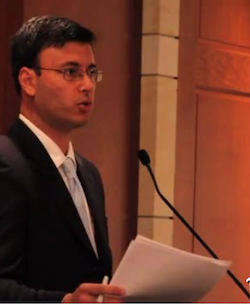 The Open Source Initiative has served as the key steward of open source software since its formation in 1998. In September 2021, the Open Source Initiative board hired Stefano Maffulli as its first Executive Director. I recently interviewed Stefano to learn more about him and his vision for the Open Source Initiative.
The Open Source Initiative has served as the key steward of open source software since its formation in 1998. In September 2021, the Open Source Initiative board hired Stefano Maffulli as its first Executive Director. I recently interviewed Stefano to learn more about him and his vision for the Open Source Initiative.
machine learning (ML)
See the following -
Accelerating Identification and Tracking of Pandemic Disease Outbreaks
 A national biosurveillance program requires the collaboration of multiple federal, state and local agencies to provide a comprehensive view of a health-related event. Bitscopic's Praedico™ biosurveillance platform breaks down the data barriers among organizations with an extensible architecture that can incorporate any kind of data. The platform also delivers high performance by incorporating the latest technologies such as big data, NoSQL databases, and machine learning. Read More »
A national biosurveillance program requires the collaboration of multiple federal, state and local agencies to provide a comprehensive view of a health-related event. Bitscopic's Praedico™ biosurveillance platform breaks down the data barriers among organizations with an extensible architecture that can incorporate any kind of data. The platform also delivers high performance by incorporating the latest technologies such as big data, NoSQL databases, and machine learning. Read More »
- Login to post comments
ASF Announces Singapore's Apache SINGA Deep Learning Tool as a Top-Level Project
 The Apache Software Foundation (ASF)...announced today Apache® SINGA™ as a Top-Level Project (TLP). Apache SINGA is an Open Source distributed, scalable machine learning library. The project was originally developed in 2014 at the National University of Singapore, and was submitted to the Apache Incubator in March 2015. "We are excited that SINGA has graduated from the Apache Incubator," said Wei Wang, Vice President of Apache SINGA and Assistant Professor at the National University of Singapore. "The SINGA project started at the National University of Singapore, in collaboration with Zhejiang University, focusing on scalable distributed deep learning. In addition to scalability, during the incubation process, built multiple versions to improve the project's usability and efficiency. Incubating SINGA at the ASF brought opportunities to collaborate, grew our community, standardize the development process, and more." Read More »
The Apache Software Foundation (ASF)...announced today Apache® SINGA™ as a Top-Level Project (TLP). Apache SINGA is an Open Source distributed, scalable machine learning library. The project was originally developed in 2014 at the National University of Singapore, and was submitted to the Apache Incubator in March 2015. "We are excited that SINGA has graduated from the Apache Incubator," said Wei Wang, Vice President of Apache SINGA and Assistant Professor at the National University of Singapore. "The SINGA project started at the National University of Singapore, in collaboration with Zhejiang University, focusing on scalable distributed deep learning. In addition to scalability, during the incubation process, built multiple versions to improve the project's usability and efficiency. Incubating SINGA at the ASF brought opportunities to collaborate, grew our community, standardize the development process, and more." Read More »
- Login to post comments
Big Tech Should Stay Out of Healthcare
 ...The use of digital technology in health care has enormous promise, to be sure. But, as the Wall Street Journal's coverage of Google's Project Nightingale revealed, there is also a potential dark side to these projects. Ascension, it noted, "also hopes to mine data to identify additional tests that could be necessary or other ways in which the system could generate more revenue from patients, documents show." That detail raises a key question that's largely overlooked in our health care debates: should the drive to maximize corporate revenues determine how health information technology develops and becomes integrated into medical practice, or should that be determined by medical science and the public?...An alternative path exists. In the 1970s, the Veterans Affairs Administration (VA) developed VistA, an open-source code system that was the country's first EHR system... Read More »
...The use of digital technology in health care has enormous promise, to be sure. But, as the Wall Street Journal's coverage of Google's Project Nightingale revealed, there is also a potential dark side to these projects. Ascension, it noted, "also hopes to mine data to identify additional tests that could be necessary or other ways in which the system could generate more revenue from patients, documents show." That detail raises a key question that's largely overlooked in our health care debates: should the drive to maximize corporate revenues determine how health information technology develops and becomes integrated into medical practice, or should that be determined by medical science and the public?...An alternative path exists. In the 1970s, the Veterans Affairs Administration (VA) developed VistA, an open-source code system that was the country's first EHR system... Read More »
- Login to post comments
Data Science Jobs Report 2019: Python Way Up, Tensorflow Growing Rapidly, R Use Double SAS
 In my ongoing quest to track The Popularity of Data Science Software, I've just updated my analysis of the job market. To save you from reading the entire tome, I'm reproducing that section here.One of the best ways to measure the popularity or market share of software for data science is to count the number of job advertisements that highlight knowledge of each as a requirement. Job ads are rich in information and are backed by money, so they are perhaps the best measure of how popular each software is now. Plots of change in job demand give us a good idea of what is likely to become more popular in the future. Read More »
In my ongoing quest to track The Popularity of Data Science Software, I've just updated my analysis of the job market. To save you from reading the entire tome, I'm reproducing that section here.One of the best ways to measure the popularity or market share of software for data science is to count the number of job advertisements that highlight knowledge of each as a requirement. Job ads are rich in information and are backed by money, so they are perhaps the best measure of how popular each software is now. Plots of change in job demand give us a good idea of what is likely to become more popular in the future. Read More »
- Login to post comments
How Can Information and Communications Tech Help in Disaster Preparedness and Response?
 n the immediate aftermath of disasters, timely and effective information is critical for the decision-making process. Information and Communication Technologies (ICTs) play a significant role in mitigation, preparedness, response, and rehabilitation by facilitating the flow of vital information in a timely manner. To deliver and deploy telecommunications / information and communication resources (transportable, easy to deploy and reliable systems that are non-exclusive) in a timely manner in the event of disasters, the ITU has designed the ITU Framework for Cooperation in Emergencies (IFCE). Innovative technologies such as robotics, drone technology, GIS, and emerging technologies like artificial intelligence (AI), the Internet of Things (IoT), cloud computing and Big Data are transforming the complex process of disaster management.
n the immediate aftermath of disasters, timely and effective information is critical for the decision-making process. Information and Communication Technologies (ICTs) play a significant role in mitigation, preparedness, response, and rehabilitation by facilitating the flow of vital information in a timely manner. To deliver and deploy telecommunications / information and communication resources (transportable, easy to deploy and reliable systems that are non-exclusive) in a timely manner in the event of disasters, the ITU has designed the ITU Framework for Cooperation in Emergencies (IFCE). Innovative technologies such as robotics, drone technology, GIS, and emerging technologies like artificial intelligence (AI), the Internet of Things (IoT), cloud computing and Big Data are transforming the complex process of disaster management.
- Login to post comments
Informatics Education
 Informatics Education was created in 2007 as the business entity in support of the first edition of our textbook Health Informatics: Practical Guide for Healthcare and Information Technology Professionals. Newer editions were published every 1-2 years with the seventh edition published in June 2018...Since the inception of Informatics Education, the vision has been to support informatics students and faculty.
Informatics Education was created in 2007 as the business entity in support of the first edition of our textbook Health Informatics: Practical Guide for Healthcare and Information Technology Professionals. Newer editions were published every 1-2 years with the seventh edition published in June 2018...Since the inception of Informatics Education, the vision has been to support informatics students and faculty.
- Login to post comments
Interview with Stefano Maffulli First Executive Director of the Open Source Initiative
- Login to post comments
Machine Learning in Healthcare: Part 1 - Learn the Basics
 This article is the first in a three-part series that will discuss how machine learning impacts healthcare. The first article will be an overview defining machine learning and explaining how it fits into the larger fields of data science and artificial intelligence. The second article will discuss machine learning tools available to the average healthcare worker. The third article will use a common open source machine learning software application to analyze a healthcare spreadsheet. Part I was written to help healthcare workers understand the fundamentals of machine learning and to make them aware that there are simple and affordable programs available that do not require programming skills or mathematics background...
This article is the first in a three-part series that will discuss how machine learning impacts healthcare. The first article will be an overview defining machine learning and explaining how it fits into the larger fields of data science and artificial intelligence. The second article will discuss machine learning tools available to the average healthcare worker. The third article will use a common open source machine learning software application to analyze a healthcare spreadsheet. Part I was written to help healthcare workers understand the fundamentals of machine learning and to make them aware that there are simple and affordable programs available that do not require programming skills or mathematics background...
- Login to post comments
Machine Learning in Healthcare: Part 2 - Tools Available to the Average Healthcare Worker
 A variety of machine learning tools are now available that can be part of the armamentarium of many industries, to include healthcare. Users can choose from commercial expensive applications such as Microsoft Azure Machine Learning Studio, SAS Artificial Intelligence Solutions or IBM SPSS Modeler. Academic medical centers and universities commonly have licenses for commercial statistical/machine learning packages so this may be their best choice. The purpose of this article is to discuss several free open source programs that should be of interest to anyone trying to learn more about machine learning, without the need to know a programming language or higher math.
A variety of machine learning tools are now available that can be part of the armamentarium of many industries, to include healthcare. Users can choose from commercial expensive applications such as Microsoft Azure Machine Learning Studio, SAS Artificial Intelligence Solutions or IBM SPSS Modeler. Academic medical centers and universities commonly have licenses for commercial statistical/machine learning packages so this may be their best choice. The purpose of this article is to discuss several free open source programs that should be of interest to anyone trying to learn more about machine learning, without the need to know a programming language or higher math.
- Login to post comments
Machine Learning in Healthcare: Part 3 - Time for a Hands-On Test
 Every inpatient and outpatient EHR could theoretically be integrated with a machine learning platform to generate predictions, in order to alert clinicians about important events such as sepsis, pulmonary emboli, etc. This approach may become essential when genetic information is also included in the EHR which would mandate more advanced computation. However, using machine learning and artificial intelligence (AI) in every EHR will be a significant undertaking because not only do subject matter experts and data scientists need to create and validate the models, they must be re-tested over time and tested in a variety of patient populations. Models could change over time and might not work well in every healthcare system. Moreover, the predictive performance must be clinically, and not just statistically significant, otherwise, they will be another source of “alert fatigue.”
Every inpatient and outpatient EHR could theoretically be integrated with a machine learning platform to generate predictions, in order to alert clinicians about important events such as sepsis, pulmonary emboli, etc. This approach may become essential when genetic information is also included in the EHR which would mandate more advanced computation. However, using machine learning and artificial intelligence (AI) in every EHR will be a significant undertaking because not only do subject matter experts and data scientists need to create and validate the models, they must be re-tested over time and tested in a variety of patient populations. Models could change over time and might not work well in every healthcare system. Moreover, the predictive performance must be clinically, and not just statistically significant, otherwise, they will be another source of “alert fatigue.”
- Login to post comments
On the Need for a Universal Health Record
 The current path of progress of the EHR, with its concentration on “meaningful use,” and an intellectual property regime that does not fully exploit the capacity for innovation by end-users is approaching an evolutionary dead-end. It is time to treat the EHR as what it should be: an integral part of medical care that has limitless potential for maximizing the use of information acquired in the provision of health care, and not an impediment to optimal care and a bugaboo for the physician. Read More »
The current path of progress of the EHR, with its concentration on “meaningful use,” and an intellectual property regime that does not fully exploit the capacity for innovation by end-users is approaching an evolutionary dead-end. It is time to treat the EHR as what it should be: an integral part of medical care that has limitless potential for maximizing the use of information acquired in the provision of health care, and not an impediment to optimal care and a bugaboo for the physician. Read More »
- Login to post comments
Open Source Initiative Names Stefano Maffulli As First Executive Director
 The Open Source Initiative ® (OSI), stewards of the Open Source Definition that sets the foundation for the open source ecosystem, is excited to announce Stefano Maffulli as its first Executive Director. The appointment is a key step for the transformation of OSI into a professionally managed organization, a process that the Board of Directors started in 2020. After an expansive search led by OSI’s purpose-built staffing committee, the Board of Directors appointed Maffulli, an experienced international leader in enterprise and open source environments.
The Open Source Initiative ® (OSI), stewards of the Open Source Definition that sets the foundation for the open source ecosystem, is excited to announce Stefano Maffulli as its first Executive Director. The appointment is a key step for the transformation of OSI into a professionally managed organization, a process that the Board of Directors started in 2020. After an expansive search led by OSI’s purpose-built staffing committee, the Board of Directors appointed Maffulli, an experienced international leader in enterprise and open source environments.
- Login to post comments
Transforming Health Care Through A 360-Degree View Of Data
 How medical care can be substantially improved through a full spectrum view of all factors that affect health was the topic of Payam Etminani's presentation at the 2019 IDGA Veterans Benefits Conference in Washington D.C. Etminani, the CEO of Bitscopic, argued that the ability to view all health data including social, environmental and genomic information in addition to the traditional clinical measures (vital signs, blood work, history of illness etc), would lead to significant improvement in care. Etminani described how recent advances in Big Data and Artificial Intelligence (AI) make combining and using these large and widely varied sets of information possible. Read More »
How medical care can be substantially improved through a full spectrum view of all factors that affect health was the topic of Payam Etminani's presentation at the 2019 IDGA Veterans Benefits Conference in Washington D.C. Etminani, the CEO of Bitscopic, argued that the ability to view all health data including social, environmental and genomic information in addition to the traditional clinical measures (vital signs, blood work, history of illness etc), would lead to significant improvement in care. Etminani described how recent advances in Big Data and Artificial Intelligence (AI) make combining and using these large and widely varied sets of information possible. Read More »
- Login to post comments
VA Selects Bitscopic's Praedico for Public Health Surveillance
 Bitscopic Inc., a leading provider of health analytics tools, announced today that the U.S. Department of Veterans Affairs (VA) has selected its Praedico platform to detect and monitor infectious disease outbreaks across the country. In addition, the VA is going to pilot Bitscopic's advanced analytics software for the early detection and management of hospital acquired infections (HAI) and other clinical informatics applications. Bitscopic's Praedico scans data from electronic health records (EHRs), laboratories, pharmacies, and other sources in seconds. It has been used to analyze infectious disease data including influenza, dengue, Hepatitis C (HCV), etc. Praedico is a modular, highly configurable, and customizable platform. It can detect and monitor large-scale events such as antibiotic resistance trends and potential major disease outbreaks. In addition, it monitors more localized events and tools, such as patient monitoring devices, and surgical site infections. Read More »
Bitscopic Inc., a leading provider of health analytics tools, announced today that the U.S. Department of Veterans Affairs (VA) has selected its Praedico platform to detect and monitor infectious disease outbreaks across the country. In addition, the VA is going to pilot Bitscopic's advanced analytics software for the early detection and management of hospital acquired infections (HAI) and other clinical informatics applications. Bitscopic's Praedico scans data from electronic health records (EHRs), laboratories, pharmacies, and other sources in seconds. It has been used to analyze infectious disease data including influenza, dengue, Hepatitis C (HCV), etc. Praedico is a modular, highly configurable, and customizable platform. It can detect and monitor large-scale events such as antibiotic resistance trends and potential major disease outbreaks. In addition, it monitors more localized events and tools, such as patient monitoring devices, and surgical site infections. Read More »
- Login to post comments
